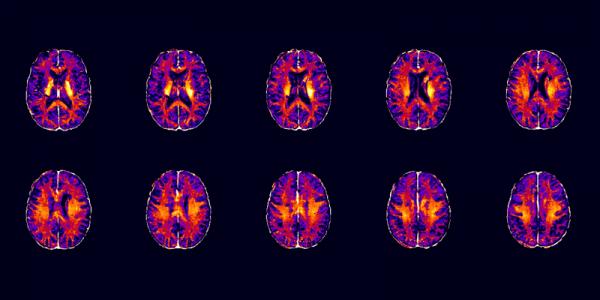
A new facility at the Djavad Mowafaghian Centre for Brain Health (DMCBH) will provide researchers with the ability to design more robust research studies— including cheaper and more efficient clinical trials— as well as to make research participation more convenient, and create new training opportunities for students and postdocs. The facility is unique in that it houses Canada’s only simultaneous positron emission tomography and magnetic resonance imaging (PET-MRI) machine dedicated to brain-related research only; this is the first General Electric (GE) Healthcare PET-MRI in Canada. For more information, please click here.
“Imaging techniques no longer work in isolation or focus on a specific disease,” said Dr. Vesna Sossi, Professor in the Department of Physics and Astronomy and Adjunct Professor in Medicine as well as Director of the UBC PET-MRI Imaging Centre. “Using this unique and highly specialised technology, we will be able to take what we discover in researching one disorder, and apply it to others for a better picture of the brain in health and disease.”
Positron emission tomography (PET) works by following the movement of light-emitting tracers through the body to monitor chemical processes in real time. PET works with traditional magnetic resonance imaging (MRI) to provide a deeper level of insight into what is happening in the body, both in tissues and metabolic processes.
In 2017, Dr. Vesna Sossi received $4.3 million from the Canada Foundation for Innovation (CFI) to acquire a hybrid PET-MRI, a machine that will allow scientists to “see” how neurochemistry overlaps with the brain’s energy consumption and how it affects neural connectivity, which will allow her team to gain a better understanding of the mechanisms underlying most—if not all—brain-related illnesses. The CFI funding was matched by Charles Fipke, bringing to reality a dream held by researchers at the University of British Columbia (UBC) for nearly a decade.
Fipke’s donation is part of a larger gift, which was announced in 2014 to benefit the imaging suite as well as Alzheimer’s research and a professorship for Dr. Haakon Nygaard.
CUTTING THE RIBBON
A dream come true for researchers like Dr. Sossi and Dr. Alex MacKay, Professor of Radiology in the Faculty of Medicine and in the Department of Physics and Astronomy, and Director of the MRI Research Centre, the Charles E. Fipke Integrated Neuroimaging Suite opened today at the DMCBH. Named for its visionary donor, the Suite combines leading edge technology and world class infrastructure.
In addition to the GE PET-MRI, the suite is also home to a new Philips Elition 3T-MRI (also the first of its kind in Canada). An older 3T-MRI is housed in UBC Hospital, and has supported over 350 research studies, most focused on the brain. Under the leadership of Dr. Mackay, the UBC MRI Research Centre has served as a non-profit resource to support leading-edge MRI research, including clinical trials on campus. In 1994, MacKay and his team developed a technique known as myelin water imaging; conventional MRI cannot distinguish between inflammation, demyelination, remyelination, and axonal damage in diseases like multiple sclerosis, but techniques developed and implemented by MacKay’s team have improved the sensitivity of MRI and afforded researchers afforded a higher level of specificity and created the ability to better understand the underlying processes occurring in neurological disease.
“This is an incredible opportunity for clinically oriented researchers to connect more closely with our colleagues in basic science,” explained Dr. Jon Stoessl, Co-Director of the DMCBH and Head, Division of Neurology in UBC’s Faculty of Medicine. “We have a long history of ground-breaking discoveries informed by our imaging researchers, but to have a PET-MRI that is devoted to brain research alone will enable us to move forward much more rapidly and efficiently.”
A TRULY INTERDISCIPLINARY PARTNERSHIP EVOLVES
In addition to its cutting edge technology, the Suite leverages an already strong relationship between TRIUMF and the UBC neuroscience community. UBC has a proud history of leading innovations in imaging research; the first PET scanner at UBC was built through collaboration between Dr. Donald Calne, then Director of the Pacific Parkinson’s Research Centre, and nuclear physicists at TRIUMF; when the original PET facility opened in 1983, it was inaugurated by HRH Queen Elizabeth II.
UBC was among the first universities in Canada to acquire neuroimaging technology, which, combined with strong expertise in neurology, radiology, physics, radiotracer production, and neuroscience, enabled ground-breaking research in Parkinson’s disease and Multiple Sclerosis soon after its arrival at UBC.
Given the proximity of DMCBH and TRIUMF on campus, a new line was installed underground on Wesbrook Mall to facilitate transfer of radioactive tracers, which are used to provide quantitative information on molecular and cellular processes in the body during PET imaging.
“This line could not have existed if the DMCBH or TRIUMF were located anywhere but where they are on campus,” said Dr. Brian MacVicar, Professor in the Department of Psychiatry and Co-Director of the DMCBH. “These relationships, and this unique facility, are equipping us with new research capabilities that will benefit British Columbians for decades to come.”
We are grateful to Chuck Fipke and our incredible community of donors. We also appreciate the tremendous efforts of Dr. Sossi and Dr. Alex MacKay in bringing the Suite to fruition.

